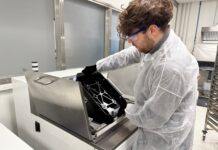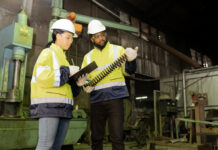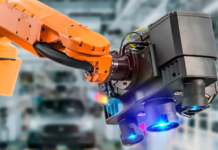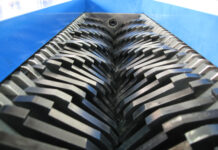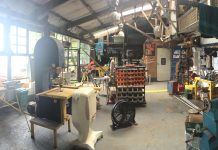Welding Strong Relationships
ESAB MIG Aluminum Systems Keep Trailer Production Rolling at High Speed at Trailstar International
“Relationships mean a lot to me,” says Tom Hahn, president of Trailstar International, a leading manufacturer of aluminum body dump trailers in Alliance, Ohio. “I can count on ESAB Account Manager Bill DiMuzio or any of my reps to come in from ESAB. They’re willing to come to us with projects and say, ‘Hey, we’ve got this new welder. Will you try it out?’ Well, they’ll bring it in, and we’ll beat the hell out of it, find any bugs and help ESAB fix them.”
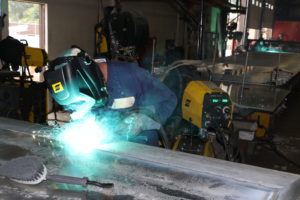 The relationship between ESAB, Trailstar and Hahn goes back decades. Since the 1980s, the ESAB 452 CC/CV power source, ST-21 MIG gun and AlcoTecâ aluminum wire have been their mainstay. With such a strong relationship, DiMuzio wanted Trailstar to be among the first U.S. companies to try the Warriorâ 500i CC/CV inverter-based welding system when ESAB introduced it in 2013.
The relationship between ESAB, Trailstar and Hahn goes back decades. Since the 1980s, the ESAB 452 CC/CV power source, ST-21 MIG gun and AlcoTecâ aluminum wire have been their mainstay. With such a strong relationship, DiMuzio wanted Trailstar to be among the first U.S. companies to try the Warriorâ 500i CC/CV inverter-based welding system when ESAB introduced it in 2013.
The Warrior 500i provides a top output of 500 amps and a duty cycle of 100 percent at 400 amps/36 volts — and Trailstar certainly relies on that beefy output for welding with 1/16 in. 5356 AlcoTec NT aluminum wire. Typical welding parameters are 280 amps/25 volts and higher, and welds 4 to 8 ft. long are the norm on large dump bodies. As an inverter, the Warrior 500i is smaller (H18.5 x L28.1 x W12.8 in.) and lighter (115 lbs.) than Trailstar’s older ESAB units.
At first glance, Trailstar Maintenance Supervisor Ken Sigman II was skeptical of the Warrior. “I was kind of just scratching my head because it’s smaller than the older style and I’m like, ‘Man, I just don’t foresee this thing holding up.’ But the more it got to be used … it was fabulous because it was condensed.”
That small size makes it easy for Trailstar to put the Warrior power source and feeder on a cart that can be easily moved around large trailers. For welding stations with boom-mounted feeders, the small size means that Trailstar can easily tuck the unit along the wall of its 10,000-sq.-ft.-facility, which is small for a facility that produces six to seven trailers per week.
With 40 years of welding experience, Sigman proudly states that he’s “old school when working on machinery.” His concern was that if he had to test the Warrior’s circuit boards, he wouldn’t be able to find the problem. Fortunately, “When I have to get with ESAB’s technical department, they help me solve the issues.”
Overall, the inverter-based ESAB welders have won Sigman over. “They’re very efficient, which means you don’t have a lot of maintenance involved. It just performs. It does its tasks, and it does exactly what it has to do.”
As an added bonus, the Warrior has 88% electrical efficiency and .91 power factor at rated output, so it can lower utility bills. Compared to a typical conventional 450-amp CC/CV welder, the Warrior can save $250 to $300 per year per machine. With five Warrior systems at Trailstar, that savings adds up to a good fund for the company Christmas party.
Pulsed MIG Aluminum
Most of the dump body components use thicker aluminum, typically 3/16 and ¼ in. for the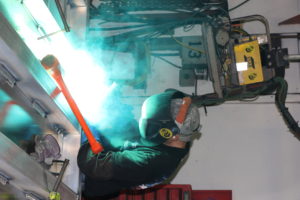 side and floor panels, and 3/8 in. or thicker for the top and bottom rails and cross members. For welding these components together, using the conventional spray transfer MIG process with 1/16-in. wire makes most sense, and it produces weld beads with excellent quality.
side and floor panels, and 3/8 in. or thicker for the top and bottom rails and cross members. For welding these components together, using the conventional spray transfer MIG process with 1/16-in. wire makes most sense, and it produces weld beads with excellent quality.
However, the tailgate uses 1/8-in. panels. Welding these panels to 3/8-in. rails with spray transfer MIG would require using a smaller diameter wire to reduce heat input. On a pound-for-pound basis, smaller diameter wires always cost more than larger diameter wires. So that Trailstar could weld all its tailgate components with one wire diameter, and to reduce spatter, DiMuzio introduced Trailstar to the Artiso Mig 4004i Pulse MIG system with U6 control. By pulsing between a high peak current (to ensure good fusion) and a low background current (to control heat input), the Aristo Mig enables using larger diameter wires to join thin-to-thick components.
“I don’t have to shut down a machine and change wire out for various welds,” says Mike Schmidt, Trailstar’s Service and Shop Manager. Without the ability to use one diameter wire, “I could be changing a machine ten times a day and slowing the [production] procedures down by having to switch to make a certain weld and then switch back. It just makes more sense to use the pulsed MIG to get the heat down a little bit when I need it.”
Schmidt also appreciates the fact that pulsed MIG nearly eliminates spatter, which makes it easier to clean the welds on the back of trailer. Trailstar wants its welds to look better than welds on any other trailer, and especially so on the tailgate, where the company name goes.
Welder/fabricator Chris Wade has used the Aristo Mig system since 2013. While he appreciates the fact that pulsed MIG means less post-weld clean-up work for him, he really appreciates the fact that the Aristo Mig system rarely causes wire burnbacks or a bird nest in the drive rolls.
“I like to keep welding when I can. You don’t want to have to stop, because when you stop, you get behind,” says Wade, who measures the life of a single contact tip in weeks or months. Wade says that he absolutely hated the Aristo Mig when Schmidt forced him to change from conventional ESAB welder. However, “After I got it hooked up and running, I fell in love with it. It’s done me good, and I love it now.”
Burnbacks Reduced 50 Percent
Trailstar has used aluminum filler wire from AlcoTec for a long time, and they’ve also tested other brands of wire. Today, they’ve settled on AlcoTec NT, or “new technology” 5XXX series wire, which applies the latest innovation in wire manufacturing technology to significantly reduce or virtually eliminate wire shavings. NT technology produces a clean, high-quality aluminum welding wire that will not clog torch liners and offers better feedability for more cost-efficient welding.
“We’ve tried other wires and had some cracking in the welds, so we switched back to the AlcoTec and problems have went away,” says Schmidt. “From what I’ve noticed on the Warrior, the feedability on the AlcoTec wire is the smoothest running machine I’ve ever ran.”
Trailstar trains its welders to blow out the MIG gun liner every time they change a wire spool. This best practice removes the shavings that can build up inside a liner and create drag on the wire.
“With some of the wires we’ve used, we’ve had the liner plug up before a roll of wire [was finished],” says Schmidt. The wire balls up, and “then you’re down. I have not had that with the AlcoTec.”
Schmidt also estimates that switching to the NT wire has reduced burnbacks by 50 percent. He attributes the reduction to the fact that the welders can always get through an entire roll of NT wire without having to stop and blow out the liner.
ST-21 Gun – the Rock Star of MIG Aluminum
The Warrior and Aristo Mig systems provide Trailstar with reliable, highly efficient performance through two daily shifts of high arc-on time, high-amperage welding. However, in Trailstar’s eyes, the real rock star of their MIG aluminum system is the ST-21. This MIG gun is water-cooled all the way to the tip, is rated at 600 amps with any shielding gas, has an in-line nozzle and pistol grip handle. Because 1/16-in. aluminum has sufficient columnar strength, it can be run through push-only MIG systems with gun cables up to 12 ft. long.
“If you’re welding aluminum, the ST-21 is what you want. It’s the Cadillac of welding guns,” says Schmidt. “Compared to the other guns, it’s night and day. If I had to personally weld with one of the other guns, I would honestly look for a different profession. It’s that much of a difference. You hate them that much, and we’ve tried all of them, your hand would be literally fried in moments. [The ST-21] just makes your day go so much better, knowing that when you pick it up, it’s going to work.”
Schmidt and Sigman both worked their way up from the shop floor, so they are intimately familiar with the qualities required in a gun used for making long aluminum welds.
“I love the ST-21. I don’t have the issues, the problems,” says Sigman. “Because let me tell you something, when you spend 8 hours, 10 hours underneath a hood and you’ve got a lot of issues with a welder, it makes for a very long day, and you get very upset. I do not have the issues with ESAB. I’ve got guns in here that probably go back 20 years, and the serviceability of that gun is great. It’s very efficient and easy to rebuild. As long as a guy respects the equipment, it will last indefinitely. It’s built with high quality.”
For more information, visit www.esab.com


